French nobility
The French nobility (French: la noblesse) was a privileged social class in France during the Middle Ages and the Early Modern period to the revolution in 1790. The nobility was revived in 1805 with limited rights as a titled elite class from the First Empire to the fall of the July Monarchy in 1848, when all privileges were permanently abolished. Hereditary titles, without privileges, continued to be granted until the Second Empire fell in 1870. They survive among their descendants as a social convention and as part of the legal name of the corresponding individuals.
 |
| Kingdom of France |
|---|
| Structure |
In the political system of pre-Revolutionary France, the nobility made up the Second Estate of the Estates General (with the Catholic clergy comprising the First Estate and the bourgeoisie and peasants in the Third Estate). Although membership in the noble class was mainly inherited, it was not a fully closed order. New individuals were appointed to the nobility by the monarchy, or they could purchase rights and titles, or join by marriage.
Sources differ about the actual number of nobles in France; however, proportionally, it was among the smallest noble classes in Europe. For the year 1789, French historian François Bluche gives a figure of 140,000 nobles (9,000 noble families) and states that about 5% of nobles could claim descent from feudal nobility before the 15th century.[1] With a total population of 28 million, this would represent merely 0.5%. Historian Gordon Wright gives a figure of 300,000 nobles (of which 80,000 were from the traditional noblesse d'épée),[2] which agrees with the estimation of historian Jean de Viguerie,[3] or a little over 1%. In terms of land holdings, at the time of the revolution, noble estates comprised about one-fifth of the land.[4]
Privileges

The French nobility had specific legal and financial rights and prerogatives. The first official list of these prerogatives was established relatively late, under Louis XI after 1440, and included the right to hunt, to wear a sword and, in principle, to possess a seigneurie (land to which certain feudal rights and dues were attached). Nobles were also granted an exemption from paying the taille, except for non-noble lands they might possess in some regions of France. Furthermore, certain ecclesiastic, civic, and military positions were reserved for nobles. These feudal privileges are often termed droits de féodalité dominante.
With the exception of a few isolated cases, serfdom had ceased to exist in France by the 15th century. In early modern France, nobles nevertheless maintained a great number of seigneurial privileges over the free peasants that worked lands under their control. They could, for example, levy the cens tax, an annual tax on lands leased or held by vassals. Nobles could also charge banalités for the right to use the lord's mills, ovens, or wine presses. Alternatively, a noble could demand a portion of vassals' harvests in return for permission to farm land he owned. Nobles also maintained certain judicial rights over their vassals, although with the rise of the modern state many of these privileges had passed to state control, leaving rural nobility with only local police functions and judicial control over violation of their seigneurial rights.
In the 17th century this seigneurial system was established in France's North American possessions.
Duties
However, the nobles also had responsibilities. Nobles were required to honor, serve, and counsel their king. They were often required to render military service (for example, the impôt du sang or "blood tax").
The rank of "noble" was forfeitable: certain activities could cause dérogeance (loss of nobility), within certain limits and exceptions. Most commercial and manual activities, such as tilling land, were strictly prohibited, although nobles could profit from their lands by operating mines, glassworks and forges. A nobleman could emancipate a male heir early, and take on derogatory activities without losing the family's nobility. If nobility was lost through prohibited activities, it could be recovered as soon as the said activities were stopped, by obtaining letters of "relief". Finally, certain regions such as Brittany applied loosely these rules allowing poor nobles to plough their own land.[5]
Forms of French nobility
The nobility in France was never an entirely closed class. Nobility and hereditary titles were distinct: while all hereditary titleholders were noble, most nobles were untitled, although many assumed titres de courtoisie. Nobility could be granted by the king or, until 1578, acquired by a family which had occupied a government or military post of high enough rank for three generations. Once acquired, nobility was normally hereditary in the legitimate male-line for all male descendants. Wealthy families found ready opportunities to pass into the nobility: although nobility itself could not, legally, be purchased, lands to which noble rights and/or title were attached could be and often were bought by commoners who adopted use of the property's name or title and were henceforth assumed to be noble if they could find a way to be exempted from paying the taille to which only commoners were subject. Moreover, non-nobles who owned noble fiefs were obliged to pay a special tax (franc-fief) on the property to the noble liege-lord. Properly, only those who were already noble could assume a hereditary title attached to a noble fief (i.e. a barony, viscounty, countship, marquisate or dukedom), thereby acquiring a title recognised but not conferred by the French crown.
The children of a French nobleman (whether a peer or not), unlike those of a British peer, were not considered commoners but untitled nobles.
Inheritance was recognized only in the male line, with a few exceptions (noblesse uterine) in the formerly independent provinces of Champagne, Lorraine and Brittany.
The king could grant nobility to individuals, convert land into noble fiefs or, elevate noble fiefs into titled estates. The king could also confer special privileges, such as peerage, on a noble fief. In general, these patents needed to be officially registered with the regional Parlement. In the case of an unwilling Parlement, the land-owner was termed à brevet (as in duc à brevet or duke by certificate).
Classes of French nobility
French nobility is generally divided into the following classes:
- Noblesse d'épée (nobility of the sword), also known as noblesse de race ("Nobility through breeding"): the hereditary gentry and nobility who originally had to swear oaths of fealty and perform military service for the King in exchange for their titles.
- Noblesse uterine ("Nobility of the female line"), was for titles that were matrilineal (held through the mother's line) and could be inherited by female heirs; this was found in some families in the former independent territories of Champagne, Lorraine and Brittany.
- Noblesse d'extraction ("Nobility of descent"): Nobility of seize-quartiers ("sixteen Quarterings"): having a coat of arms of at least sixteen quarterings (partitions on the field of a composite coat of arms showing each coat of arms the person is entitled to). This means that the person has pure noble or gentle ancestry going back at least four generations (parents [2 "quarterings"], grandparents [4 quarterings], great-grandparents [8 quarterings], and great-great-grandparents [16 quarterings]).
- Noblesse de robe (nobility of the robe): person or family made noble by holding certain official charges, like masters of requests, treasurers, or Presidents of Parlement courts.
- Noblesse de chancellerie (nobility of the chancery): commoner made noble by holding certain high offices for the king.
- Noblesse de cloche ("nobility of the bell") or Noblesse échevinale/Noblesse scabinale ("Nobility of the Aldermen"): person or family made noble by being a mayor (Bourgmestre) or alderman (échevin) or prévôt (Provost, or "municipal functionary") in certain towns (such as Abbeville and Angers, Angoulême, Bourges, Lyon, Toulouse, Paris, Perpignan, and Poitiers). Some towns and cities received the status temporarily or sporadically, like Cognac, Issoudun, La Rochelle, Lyon, Nantes, Niort, Saint-Jean-d'Angély and Tours. There were only 14 such communities by the beginning of the Revolution.
- Noblesse militaire (military nobility): person or family made noble by holding military offices, generally after two or three generations.
Nobles sometimes made the following distinctions based on the age of their status:
- Noblesse chevaleresque (knightly nobility) or noblesse ancienne ("Old Nobility"): nobility from before the year 1400, who inherited their titles from time immemorial.
- Noblesse des lettres (nobility through Letters Patent): person made noble by letters patent from after the year 1400.
Commoners were referred to as roturiers. Magistrates and men of law were sometimes called robins.
The acquisition of titles of nobility could be done in one generation or gradually over several generations:
- Noblesse au premier degré (nobility in the first generation): nobility awarded in the first generation, generally after 20 years of service or by death in one's post.
- Noblesse graduelle: nobility awarded in the second generation, generally after 20 years of service by both father and son.
The noblesse de lettres became, starting in the reign of Francis I, a handy method for the court to raise revenues; non-nobles possessing noble fiefs would pay a year's worth of revenues from their fiefs to acquire nobility. In 1598, Henry IV undid a number of these anoblissments, but eventually resumed the practice.
The noblesse de cloche dates from 1372 (for the city of Poitiers) and was found only in certain cities with legal and judicial freedoms, such as Toulouse with the "capitouls", acquiring nobility as city councillors; by the Revolution these cities were only a handful.
The noblesse de chancellerie first appeared during the reign of Charles VIII at the end of the 15th century. To hold the office of chancellor required (with few exceptions) noble status, so non-nobles given the position were raised to the nobility, generally after 20 years of service. Non-nobles paid enormous sums to hold these positions, but this form of nobility was often derided as savonnette à vilain ("soap for serfs").
The noblesse de robe existed by longstanding tradition. In 1600 it gained legal status. High positions in regional parlements, tax boards (chambres des comptes), and other important financial and official state offices (usually bought at high price) conferred nobility, generally in two generations, although membership in the Parlements of Paris, Dauphiné, Besançon and Flanders, as well as on the tax boards of Paris, Dole and Grenoble elevated an official to nobility in one generation.
These state offices could be lost by a family at the unexpected death of the office holder. In an attempt to gain more tax revenues, the king's financial advisor, financier Charles Paulet, instituted the Paulette in 1604. This was a yearly tax of 1/60th of the price of the office that insured hereditary transmission. This annual tax solidified the hereditary acquisition of public office in France, and by the middle of the 17th century the majority of office holders were already noble from long possession of thereof.
Henry IV began to enforce the law against usurpation of titles of nobility, and in 1666–1674 Louis XIV mandated a massive program of verification of hereditary titles. Oral testimony maintaining that parents and grandparents had been born noble and lived as such were no longer accepted: written proofs (marriage contracts, land documents) proving noble rank since 1560 were required to substantiate noble status. Many families were put back on the lists of the taille and/or forced to pay fines for usurping noble titles. Many documents such as notary deeds and contracts were forged, scratched or overwritten resulting in rejections by the crown officers and more fines.[6] During the same period Louis the Great in dire need of money for wars issued blank letters-patent of nobility and urged crown officers to sell them to aspiring squires in the Provinces.
Titles, peerage, and orders
There were two kinds of titles used by French nobles: some were personal ranks and others were linked to the fiefs owned, called fiefs de dignité.
During the ancien régime, there was no distinction of rank by title (except for the title of duke, which was often associated with the strictly regulated privileges of the peerage, including precedence above other titled nobles). The hierarchy within the French nobility below peers was initially based on seniority; a count whose family had been noble since the 14th century was higher-ranked than a marquis whose title only dated to the 15th century. Precedence at the royal court was based on the family's ancienneté, its alliances (marriages), its hommages (dignities and offices held) and, lastly, its illustrations (record of deeds and achievements).
- Titles:
- King
- Foreign Prince
- Duc: possessor of a duchy (duché—a feudal property, not an independent principality) and recognition as duke by the king.
- Prince: possessor of a lordship styled a principality (principauté); most such titles were held by family tradition and were treated by the court as titres de courtoisie—often borne by the eldest sons of the more important duke-peers. This title of prince is not to be confused with the rank of prince, borne by the princes du sang, the princes légitimés or the princes étrangers whose high precedence derived from their kinship to actual rulers.
- Marquis: possessor of a marquessate (marquisat), but often assumed by a noble family as a titre de courtoisie
- Comte: possessor of a county (comté) or self-assumed.
- Vicomte: possessor of a viscounty (vicomté) or self-assumed.
- Advocatus
- Baron: possessor of a barony (baronnie) or self-assumed.
- Vidame: a rare title, always with the name of a diocese, as their origin was as the commander of a bishop's forces. The Vidame de Chartres is the best known.
- Ranks:
- Fils de France: son of a king or dauphin.
- Petit-fils de France: grandson of a king in the male line.
- Prince du Sang ("prince of the blood"): a remote, legitimate male-line descendant of a king of France.[7]
- Peer of France was technically a dignity of the Crown (as, e.g., marshal of France), but became in fact the highest hereditary rank borne by the French nobility—always in conjunction with a title (e.g. "Duc et Pair", "Comte-Pair"). The peerage was originally awarded only to princes of the blood, some legitimised and foreign princes, often the heads of the kingdom's most ancient and powerful families, and a few bishops. Eventually it was almost always granted in conjunction with the title of duke. Gradually the peerage came to be conferred more broadly as a reward for distinguished military or diplomatic service, but also on favourites of the king (e.g. les mignons). The peers were entitled to seats in the Parliament of Paris, the most important judicial court in the kingdom.
- Prince légitimé: legitimised son or male-line descendant of a king. Precise rank depended upon the king's favour.
- Prince étranger ("foreign prince"): members of foreign royal or princely families naturalized at the French court, such as the Clèves, Rohan, La Tour d'Auvergne, and Lorraine-Guise.
- Chevalier: an otherwise untitled nobleman who belonged to an order of chivalry; earlier, a rank for untitled members of the oldest noble families. Later distinction was that a Knight (Sieur) went through the dubbing ceremony (touched with a sword on the head and shoulders by the King), while the lesser rank of Chevalier or Knight Bachelor received the rank without the ceremony.
- Écuyer ("Squire" and literally: "shield bearer"): lowest specific rank in the nobility, to which the vast majority of untitled nobles were entitled; also called valet or noble homme in certain regions.
- Gentilhomme: lowest non-specific rank indicating nobility
- Seigneur ("Lord of the manor" and literally: "lord"): term for the untitled owner of a feudal property; strictly, neither a title nor a rank, it indicated that a landlord's property had certain noble rights attached, although properly it did not indicate the owner was noble, especially after the 17th century.
- Bâtard: recognized bastard son of a gentleman or nobleman. They could not usually inherit a title (if any claimants of legitimate birth existed) but could be employed in their father's retinue. Bastard sons and daughters were often married off to allied or subordinate families to strengthen ties or to bind lesser families to them.
The use of the nobiliary particle de in noble names (Fr: la particule) was not officially controlled in France (unlike von in the German states), and is not reliable evidence of the bearer's nobility. In certain small parishes, every commoner from merchant to blacksmith was topped up with a "de" on church registers. In the 18th and 19th centuries, the de was adopted by large numbers of non-nobles (like Honoré de Balzac or Gérard de Nerval) in an attempt to appear noble.[8] These attempts were easily endorsed by civil officers. They were originally sneered at but became accepted within one or two generations. It has been estimated that today 90% of names with a particle are non-noble, or that only 10% of such names are carried by authentic nobility. A few authentic "extraction" nobles are even without any particle at all.[9][10][11]
Each rank of nobility — royal prince, prince belonging to collateral lines of the royal family (prince du sang), duc, marquis, comte, vicomte, baron, etc. — conferred its own privileges; dukes for example could enter royal residences in a carriage, duchesses could sit on a stool (tabouret) in the queen's presence. Dukes in France — the most important group after the princes — were further divided into those who were also "peers" (Duc et Pair) and those who were not. Dukes without a peerage fell into one of two groups: those never granted peerage fiefs by the king, and those for whom the Parlement of Paris refused to register the king's lettres patentes, permanently or temporarily, as a protest against the promotion.
Noble hierarchies were further complicated by the creation of chivalric orders – the Chevaliers du Saint-Esprit (Knights of the Holy Spirit) created by Henry III in 1578; the Ordre de Saint-Michel created by Louis XI in 1469; the Order of Saint Louis created by Louis XIV in 1696 – by official posts, and by positions in the Royal House (the Great Officers of the Crown of France), such as grand maître de la garde-robe (the grand master of the royal wardrobe, being the royal dresser) or grand panetier (royal bread server), which had long ceased to be actual functions and had become nominal and formal positions with their own privileges. The 17th and 18th centuries saw nobles and the noblesse de robe battle each other for these positions and any other sign of royal favor.
Attending the ceremony of the king's waking at Versailles (the smaller and intimate petit lever du roi and the more formal grand lever du roi), being asked to cross the barriers that separated the royal bed from the rest of the room, being invited to talk to the king, or being mentioned by the king. All were signs of favor and actively sought after.
Economic status
Economic studies of nobility in France reveal great differences in financial status. At the end of the 18th century, a well-off family could earn 100,000–150,000 livres per year, although the most prestigious families could gain two or three times that much. For provincial nobility, yearly earnings of 10,000 livres permitted a minimum of provincial luxury, but most earned far less.[12] The ethics of noble expenditure, the financial crises of the century and the inability of nobles to participate in most fields without losing their nobility contributed to their poverty.
Guy Chaussinand-Nogaret divides the nobility of France into five distinct wealth categories, based on research into the capitation tax, which nobles were also subject to. The first category includes those paying over 500 livres in capitation and enjoying at least 50,000 l. in annual income. 250 families in total comprised this group, the majority living in Paris or at court. The second group numbered around 3,500 families with incomes between 10,000 l. and 50,000 l. These were the rich provincial nobility. In the provinces, their incomes allowed them a lavish lifestyle, and they made up 13% of the nobility. The third group were the 7,000 families whose income was between 4,000 and 10,000 l. per annum, which allowed a comfortable life. In the fourth group, 11,000 noble families had between 1,000 and 4,000 l. per year. They could still lead a comfortable life provided they were frugal and did not tend toward lavish expenditures. Finally in the fifth group were those with less than 1,000 l. per year; over 5,000 noble families lived at this level. Some of them had less than 500 l., and some others had 100 or even 50 l. This group paid either no or very little capitation tax.[13]
In the 18th century, the Comte de Boulainvilliers, a rural noble, posited the belief that French nobility had descended from the victorious Franks, while non-nobles descended from the conquered Gauls. The theory had no validity, but offered a comforting myth for an impoverished noble class.[14]
Aristocratic codes
The idea of what it meant to be noble went through a radical transformation from the 16th to the 17th centuries. Through contact with the Italian Renaissance and their concept of the perfect courtier (Baldassare Castiglione), the rude warrior class was remodeled into what the 17th century would come to call l'honnête homme ('the honest or upright man'), among whose chief virtues were eloquent speech, skill at dance, refinement of manners, appreciation of the arts, intellectual curiosity, wit, a spiritual or platonic attitude in love, and the ability to write poetry. Most notable of noble values are the aristocratic obsession with "glory" (la gloire) and majesty (la grandeur) and the spectacle of power, prestige, and luxury.[15] For example, Pierre Corneille's noble heroes have been criticised by modern readers who have seen their actions as vainglorious, criminal, or hubristic; aristocratic spectators of the period would have seen many of these same actions as representative of their noble station.
The château of Versailles, court ballets, noble portraits, and triumphal arches were all representations of glory and prestige. The notion of glory (military, artistic, etc.) was seen in the context of the Roman Imperial model; it was not seen as vain or boastful, but as a moral imperative to the aristocratic classes. Nobles were required to be "generous" and "magnanimous", to perform great deeds disinterestedly (i.e. because their status demanded it – whence the expression noblesse oblige – and without expecting financial or political gain), and to master their own emotions, especially fear, jealousy, and the desire for vengeance. One's status in the world demanded appropriate externalisation (or "conspicuous consumption"). Nobles indebted themselves to build prestigious urban mansions (hôtels particuliers) and to buy clothes, paintings, silverware, dishes, and other furnishings befitting their rank. They were also required to show liberality by hosting sumptuous parties and by funding the arts.[16]
Conversely, social parvenus who took on the external trappings of the noble classes (such as the wearing of a sword) were severely criticised, sometimes by legal action; laws on sumptuous clothing worn by bourgeois existed since the Middle Ages.
Traditional aristocratic values began to be criticised in the mid 17th century: Blaise Pascal, for example, offered a ferocious analysis of the spectacle of power and François de La Rochefoucauld posited that no human act – however generous it pretended to be – could be considered disinterested.
By relocating the French royal court to Versailles in the 1680s, Louis XIV further modified the role of the nobles. Versailles became a gilded cage: to leave spelled disaster for a noble, for all official charges and appointments were made there. Provincial nobles who refused to join the Versailles system were locked out of important positions in the military or state offices, and lacking royal subsidies (and unable to keep up a noble lifestyle on seigneurial taxes), these rural nobles (hobereaux) often went into debt. A strict etiquette was imposed: a word or glance from the king could make or destroy a career. At the same time, the relocation of the court to Versailles was also a brilliant political move by Louis. By distracting the nobles with court life and the daily intrigue that came with it, he neutralized a powerful threat to his authority and removed the largest obstacle to his ambition to centralize power in France.
Power and protest
Before Louis XIV imposed his will on the nobility, the great families of France often claimed a fundamental right to rebel against unacceptable royal abuse. The Wars of Religion, the Fronde, the civil unrest during the minority of Charles VIII and the regencies of Anne of Austria and Marie de Medici are all linked to these perceived loss of rights at the hand of a centralizing royal power.
Before and immediately after the Revocation of the Edict of Nantes in 1685, many Protestant noble families emigrated and by doing so lost their lands in France. In certain regions of France a majority of the nobility had turned to Protestantism and their departure significantly depleted the ranks of the nobility. Some were incorporated into the nobility of their countries of adoption.
Much of the power of nobles in these periods of unrest comes from their "clientèle system". Like the king, nobles granted the use of fiefs, and gave gifts and other forms of patronage to other nobles to develop a vast system of noble clients. Lesser families would send their children to be squires and members of these noble houses, and to learn in them the arts of court society and arms.
The elaboration of the ancien régime state was made possible only by redirecting these clientèle systems to a new focal point (the king and the state), and by creating countervailing powers (the bourgeoisie, the noblesse de robe).[17] By the late 17th century, any act of explicit or implicit protest was treated as a form of lèse-majesté and harshly repressed.
The French Revolution

At the beginning of the French Revolution, on August 4, 1789 the dozens of small dues that a commoner had to pay to the lord, such as the banalités of Manorialism, were abolished by the National Constituent Assembly; noble lands were stripped of their special status as fiefs; the nobility were subjected to the same taxation as their co-nationals, and lost their privileges (the hunt, seigneurial justice, funeral honors). The nobles were, however, allowed to retain their titles. This did not happen immediately. Decrees of application had to be drafted, signed, promulgated and published in the Provinces, such that certain noble rights were still being applied well into 1791.
Nevertheless, it was decided that certain annual financial payments which were owed the nobility and which were considered "contractual" (i.e. not stemming from a usurpation of feudal power, but from a contract between a landowner and a tenant) such as annual rents (the cens and the champart) needed to be bought back by the tenant for the tenant to have clear title to his land. Since the feudal privileges of the nobles had been termed droits de feodalité dominante, these were called droits de féodalité contractante. The rate set (May 3, 1790) for purchase of these contractual debts was 20 times the annual monetary amount (or 25 times the annual amount if given in crops or goods); peasants were also required to pay back any unpaid dues over the past thirty years. No system of credit was established for small farmers, and only well-off individuals could take advantage of the ruling. This created a massive land grab by well-off peasants and members of the middle-class, who became absentee landowners and had their land worked by sharecroppers and poor tenants.[18]
The Declaration of the Rights of Man and of the Citizen had adopted by vote of the Assembly on August 26, 1789, but the abolition of nobility did not occur at that time. The Declaration declared in its first article that "Men are born free and equal in rights; social distinctions may be based only upon general usefulness." It was not until June 19, 1790, that hereditary titles of nobility were abolished. The notions of equality and fraternity won over some nobles such as the Marquis de Lafayette who supported the abolition of legal recognition of nobility, but other liberal nobles who had happily sacrificed their fiscal privileges saw this as an attack on the culture of honor.
Nobility since the Revolution
Nobility and hereditary titles were abolished by the Revolutions of 1789 and 1848, but hereditary titles were restored by decree in 1852 and have not been abolished by any subsequent law. However, since 1875 the President of the Republic neither confers nor confirms French titles (specific foreign titles continued to be authorised for use in France by the office of the President as recently as 1961), but the French state still verifies them; civil courts can protect them; and criminal courts can prosecute their abuse.
The Bourbon Restoration of Louis XVIII saw the return of the old nobility to power (while ultra-royalists clamored for a return of lost lands). The electoral laws of 1817 limited suffrage to only the wealthiest or most prestigious members (less than 0.5%) of the population, which included many of the old nobility.
Napoléon Bonaparte established his own hereditary titles during the Empire, and these new aristocrats were confirmed in legal retention of their titles even after his overthrow. In all, about 2200 titles were created by Napoleon I:
- Princes and Dukes:
- sovereign princes (3)
- duchies grand fiefs (20)
- victory princes (4)
- victory dukedoms (10)
- other dukedoms (3)
- Counts (251)
- Barons (1516)
- Knights (385)
In 1975, there were 239 remaining families holding First Empire titles. Of those, perhaps 130–140 were titled. Only one title of prince and seven titles of duke remain.
Napoleon also established a new knightly order in 1802, the Légion d'honneur, which still exists but is not officially hereditary. Napoleon had decided by decree that three successive generations of legionnaires would confer the family hereditary nobility with the title of "chevalier". A small number of French families meet the requirement but the Napoleonic decree was abrogated and is not applied today.
Between 1830 and 1848 Louis Philippe, King of the French retained the House of Peers established by the Bourbons under the Restoration, although he made the peerage non-hereditary, and granted hereditary titles, but without "nobility".
The Second Empire of Napoleon III also conferred hereditary titles until monarchy was again abolished in 1870. While the Third Republic returned once again to the principles of equality espoused by the Revolution (at least among the political Radical party), in practice the upper echelons of French society maintained their notion of social distinction well into the 20th century (as attested to, for example, by the presence of nobility and noble class distinctions in the works of Marcel Proust).
The First World War took a huge toll on noble families. It has been estimated that one third of noble family names became extinct through the deaths of their last bearers.
French courts have, however, held that the concept of nobility is incompatible with the equality of all citizens before the law proclaimed in the Declaration of the Rights of Man of 1789, and which remains part of the Constitution of 1958. "Nobility", as a legal concept and status, has therefore been effectively abolished in France.
Nonetheless, extant titles which were hereditary under one of France's monarchical regimes are considered part of the legal name which descend according to their original grants (insofar as they pass from and to males only).[19] They are incapable of becoming a legal part of the name by self-assumption or prolonged usage,[20] and are entitled to the same protections in French civil and criminal courts as the name, even though they afford neither privilege nor precedence (cf. peerage of the United Kingdom).[21] Regulation of titles is carried out by a bureau of the Ministry of Justice, which can verify and authorize the bearer to make legal use of the title in official documents such as birth certificates.[22]
Symbols
In France, the signet ring (chevalière) bearing a coat of arms is not, by far, a sign or proof of nobility; thousands of bourgeois families were allowed to register their arms, and they often bore them "as if". At best the ring is a more or less discreet sign of allegiance to certain values, moral virtue and cultural heritage.
However all noble families do have a coat of arms. The ring is traditionally worn by Frenchmen on the ring finger of their left hand, contrary to usage in most other European countries (where it is worn on the little finger of either the right or left hand, depending on the country); French women however wear it on their left little finger. Daughters sometimes wear the signet ring of their mother if the father lacks a coat of arms, but a son would not.
The chevalière may either be worn facing up (en baise-main) or facing toward the palm (en bagarre). In contemporary usage, the inward position is increasingly common, although for some noble families the inward position is traditionally used to indicate that the wearer is married.
There is no legal or formal control or protection over signet ring carrying.
Ancien Régime
 |
King (Roi de France) | 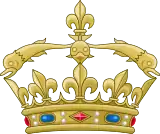 |
Dauphin of France | Royal Prince of the Blood | Prince of the Blood | ||
| Duke and Peer of France | Duke | Marquis and Peer of France | Marquis | ||||
| Count and Peer of France | Count | Count (older) | Viscount | ||||
| Vidame | Baron | Knight's crown | Knight's tortillon |
Napoleonic Empire
 |
Emperor |  |
Prince Imperial |  |
Prince |  |
Duke |
 |
Count |  |
Baron |  |
Knight | Bonnet d'honneur | |
July Monarchy
 |
King of the French |
Gallery
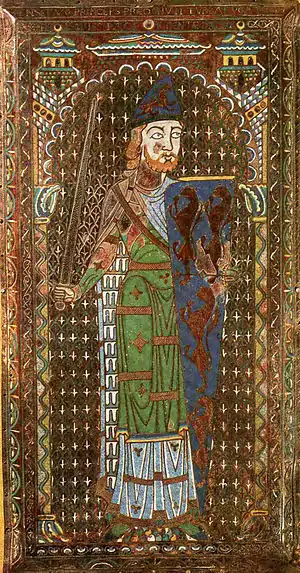 Geoffrey Plantagenet, Count of Anjou (1113–1151)
Geoffrey Plantagenet, Count of Anjou (1113–1151) Joan II, Countess of Auvergne (1378–1424)
Joan II, Countess of Auvergne (1378–1424)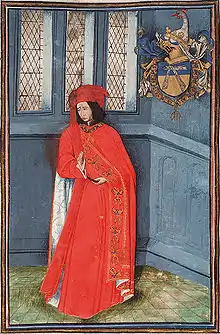 Jean de Villiers de L'Isle-Adam (1384–1437)
Jean de Villiers de L'Isle-Adam (1384–1437) Philip I de Croÿ (1435–1511)
Philip I de Croÿ (1435–1511) Louis d'Armagnac, Duke of Nemours (1472–1503)
Louis d'Armagnac, Duke of Nemours (1472–1503) Charles II d'Amboise (1473–1511)
Charles II d'Amboise (1473–1511) Armand de Gontaut, baron de Biron (15241592)
Armand de Gontaut, baron de Biron (15241592) Henri I de Montmorency (1534–1614)
Henri I de Montmorency (1534–1614) François de Bonne, Duke of Lesdiguières (1543–1626)
François de Bonne, Duke of Lesdiguières (1543–1626) Claude de La Trémoille (1566–1604)
Claude de La Trémoille (1566–1604) Henri II d'Orléans, Duke of Longueville (1595–1663)
Henri II d'Orléans, Duke of Longueville (1595–1663).jpg.webp) Gabriel de Rochechouart de Mortemart (1600–1675)
Gabriel de Rochechouart de Mortemart (1600–1675) Marie de Bourbon, Duchess of Montpensier (1605–1627)
Marie de Bourbon, Duchess of Montpensier (1605–1627) Henri de La Tour d'Auvergne, Vicomte de Turenne (1611–1675)
Henri de La Tour d'Auvergne, Vicomte de Turenne (1611–1675)
 Henry II, Duke of Guise (1614–1664)
Henry II, Duke of Guise (1614–1664).jpg.webp) Marie d'Orléans-Longueville (1625–1707)
Marie d'Orléans-Longueville (1625–1707) Anne Hilarion de Tourville (1642–1701)
Anne Hilarion de Tourville (1642–1701) Madeleine de l’Aubespine (1646–1696)
Madeleine de l’Aubespine (1646–1696)
 Madame de Ventadour (1654–1755)
Madame de Ventadour (1654–1755) François Louis, Prince of Conti (1664–1709)
François Louis, Prince of Conti (1664–1709).jpg.webp) François-Marie, 1st duc de Broglie (1671–1745)
François-Marie, 1st duc de Broglie (1671–1745)_-_Portret_van_maarschalk_hertog_Richelieu_-_Lissabon_Museu_Calouste_Gulbenkian_21-10-2010_13-34-54.jpg.webp) Armand de Vignerot du Plessis (1696–1788)
Armand de Vignerot du Plessis (1696–1788)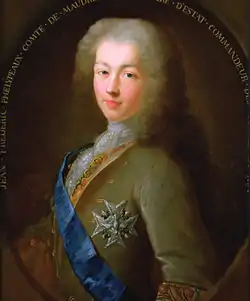 Jean-Frédéric Phélypeaux, Count of Maurepas (1701–1781)
Jean-Frédéric Phélypeaux, Count of Maurepas (1701–1781) François-Henri d'Harcourt (1726–1802)
François-Henri d'Harcourt (1726–1802)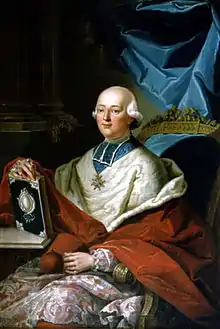 Cardinal de Rohan (1734–1803)
Cardinal de Rohan (1734–1803)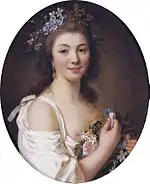 Stéphanie Félicité, comtesse de Genlis (1746–1830)
Stéphanie Félicité, comtesse de Genlis (1746–1830).jpg.webp) Armand Louis de Gontaut (1753–1793)
Armand Louis de Gontaut (1753–1793) Charles Maurice de Talleyrand-Périgord (1754–1838)
Charles Maurice de Talleyrand-Périgord (1754–1838) Gilbert du Motier, Marquis de Lafayette (1757–1834)
Gilbert du Motier, Marquis de Lafayette (1757–1834) Patrice de Mac Mahon, duc de Magenta (1808–1894)
Patrice de Mac Mahon, duc de Magenta (1808–1894) Théodolinde de Beauharnais (1814–1857)
Théodolinde de Beauharnais (1814–1857) Agenor, duc de Gramont (1819–1880)
Agenor, duc de Gramont (1819–1880)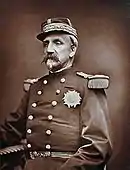 Henri d'Orléans, Duke of Aumale (1822–1897)
Henri d'Orléans, Duke of Aumale (1822–1897).jpg.webp) Prince Jean, Duke of Guise (1874–1940)
Prince Jean, Duke of Guise (1874–1940) Antoine, conte de Saint-Exupéry (1900–1944)
Antoine, conte de Saint-Exupéry (1900–1944) Philippe Leclerc de Hauteclocque (1902–1947)
Philippe Leclerc de Hauteclocque (1902–1947).jpg.webp) Jean-Dominique Senard (1953)
Jean-Dominique Senard (1953) Henri de Castries (1954)
Henri de Castries (1954)
See also
Notes
- Bluche, 84.
- Wright, 15.
- Viguerie, 1232.
- Hobsbawm, 57, citing Henri Eugène Sée's Esquisse d'une histoire du régime agraire en Europe aux XVIIIe et XIXe siècles (1991).
- Pike, John (2011). "Nobility - Classes and Precedence". Global Security org.
- Dewever, Richard (June 2017). "On the changing size of nobility under Ancien Régime, 1500-1789∗" (PDF). Paris School of Economics.
- some very remote but legitimate descendants of French kings were never acknowledged by the Valois or Bourbon kings as princes of the blood royal, e.g. the Princes de Carency, cadets of Jean I de Bourbon, Count of La Marche and the Princes de Courtenay, cadets of Louis VI of France
- Lucas, Colin (August 1973). "Nobles, Bourgeois and the Origins of the French Revolution". Past & Present. Oxford University Press. 60: 90–91. doi:10.1093/past/60.1.84.
- Velde, François R. (June 2008). "Nobility and Titles in France". Heraldica.
- McDermott, John Francis (1941). A Glossary of Mississippi Valley French, 1673-1850, Números 12-13. Book on Demand. p. 65. ISBN 9785873562893.
- Mordell, Anne (January 2018). "Everyone Wants a French Noble Among Their Ancestors". The French Genealogy.
- Viguerie, 1233.
- Chaussinand-Nogaret, Guy; p. 53
- Viguerie, 781–82.
- See Bénichou.
- For more on this, see Elias. This kind of expenditure mandated by social status also links to the theories of sociologist Marcel Mauss on the "gift".
- See Major.
- See Soboul, 192–195 for information on the abolition of privileges.
- "La transmission des titres ne se fait plus, dans le droit moderne, que de mâle à mâle." Trib. Civ. Falaise, 21 Fév 1959
- "si le titre nobiliaire suit, en général, les règles du nom patronymique, il ne s'acquiert pas, comme lui, par le simple usage, même prolongé; il lui faut, à l'origine, une investiture émanant de l'autorité souveraine" Civ. 11 mai 1948, Dalloz 1948 335.
- "Les titres nobiliaires, dépouillés aujourd'hui de tout privilège féodal et même de tout privilège de rang, n'ont plus qu'un caractère personnel et honorofique et ne peuvent même plus être considérés, du point de vue juridique, que comme un complément du nom patronymique permettant de mieux distinguer l'identité des personnes, tout en perpétuant de grands souvenirs; si, en vertu de cette sorte de lien de subordination entre le titre nobiliaire et le nom patronymique, il est dû la même protection au titre qu'au nom, on ne lui doit pas une protection spéciale et privilégiée." Paris, 2 Jan 1896. Dalloz 1896 2.328
- Texier, Alain. Qu'est-ce que la noblesse? Paris, 1987, pp. 407-10
References
- Bénichou, Paul. Morales du grand siècle. Paris: Gallimard, 1948. ISBN 2-07-032473-7
- Bluche, François. L'Ancien Régime: Institutions et société. Collection: Livre de poche. Paris: Fallois, 1993. ISBN 2-253-06423-8
- Chaussinand-Nogaret, Guy. The French Nobility in the Eighteenth Century. Cambridge: Cambridge University Press, 1985.
- Ford, Franklin L. Robe & Sword: The Regrouping of the French Aristocracy after Louis XIV. Cambridge MA: Harvard University Press, 1953.
- Dioudonnat, Pierre-Marie. Encyclopedie de la Fauss Noblesse et de la Noblesse d’Apparence. New ed. Paris: Sedopols, 1994.
- Hobsbawm, Eric. The Age of Revolution. New York: Vintage, 1996. ISBN 978-0-679-77253-8
- La Chesnaye-Desbois et Badier, François de (comp). Dictionnaire de la Noblesse de la France. 3d ed. 18v. Paris: Bachelin-Deflorenne, 1868–73 (Kraus-Thomson Organization, 1969).
- Major, J. Russell. From Renaissance Monarchy to Absolute Monarchy: French Kings, Nobles & Estates. Baltimore: Johns Hopkins, 1994. ISBN 0-8018-5631-0
- Elias, Norbert. The Court Society. (Originally publ., 1969) New York: Pantheon, 1983. ISBN 0-394-71604-3
- Pillorget, René and Suzanne Pillorget. France Baroque, France Classique 1589–1715. Collection: Bouquins. Paris: Laffont, 1995. ISBN 2-221-08110-2
- Soboul, Albert. La Révolution française. Paris: Editions Sociales, 1982. ISBN 2-209-05513-X
- Viguerie, Jean de. Histoire et dictionnaire du temps des Lumières 1715-1789. Collection: Bouquins. Paris: Laffont, 1995. ISBN 2-221-04810-5
- Wright, Gordon. France in Modern Times. 4th ed. New York: Norton, 1987. ISBN 0-393-95582-6
